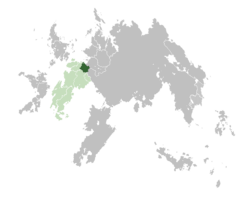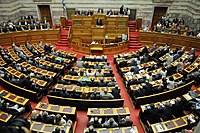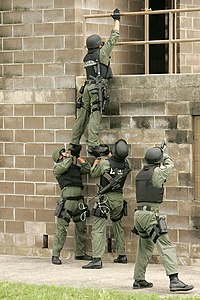Brilliania
This article is incomplete because it is pending further input from participants, or it is a work-in-progress by one author. Please comment on this article's talk page to share your input, comments and questions. Note: To contribute to this article, you may need to seek help from the author(s) of this page. |
Federal Republic of Brilliania Errepublika Federala Berilinakoren (Brillian language) Berílet szövetségi köztársaság (Iparinan language) | |
|---|---|
|
Flag | |
| Motto: Mantendu egingo dugu We will maintain | |
| Anthem: Ereszerki (Hymn) | |
 Location of Brilliania (dark green) in Cardia (green) | |
| Capital | Szaranegertu |
| Largest | Martirien Herria |
| Official languages | Brillian, Iparinan |
| Demonym(s) | Brillian |
| Government | Federal presidential republic |
| Endrike Karagori (BM} | |
| Alcsai Vikuna (Ind.) | |
| vacant | |
• Speaker of the National Assembly | Gencen Arinszano (BM} |
| Legislature | National Assembly |
| Independence from Cornicae 1943 | |
| Population | |
• 2017 census | 18,792,090 |
| GDP (nominal) | 2017 estimate |
• Total | $311,478,891,750 |
• Per capita | $16,575 |
| Gini (2016) | medium |
| HDI (2017) | very high |
| Currency | Brillian Florrin (EBF) |
| Date format | yyyy-mm-dd |
| Driving side | right |
| ISO 3166 code | EB |
| Internet TLD | .eb |
Brilliania (Brillian: Berilinako), officially the Federal Republic of Brilliania, (Brillian: Errepublika Federala Berilinakoren, Iparinan: Berílet szövetségi köztársaság) is a sovereign state in northeastern Cardia, bordered by the XXX sea and the nations of Vetonia to the west, Dulebia to the east and Finium to the south. Administratively, the nation consists of 5 states and the federal capital of Szaranegertu. It is administered as a federal presidential republic with a population of 18,792,090 citizens which mostly consist of members of the isolated Brillian-speaking Brillian people. Minorities include the Iparinans from the southeastern region of Iparina and Rodenians and Iverdorians in areas close to the border with Vetonia.
Brilliania was ruled by a monarchy between xxx and 1605, starting when Prince Ganis unified several Brillian towns in the year xxx, and ending with the forced suicide of Prince Ilurdo in 1605.
Brilliania is a developed country with a high-income service-based economy. It ranks highly in the Human Development Index. Although recent governments have prioritized the increasement of social security programmes, most Brillian citizens in rural areas are poorer than average. Although the domestic economy of Brilliania is strong, foreign trade is low due to Brilliania's former international isolation during a period of semi-authoritarian rule.
History
Prehistory
Kingdom (xxx - 1605)
Cornica
Brillian Salvationism
Since the start of repression against the longstanding Marist tradition, most Marists have attempted resettlement in the heritage nation of their religion. In 1904, under leadership of Innigo Alveri, the concept of Brillian Salvationism was codified and included the struggle and resistance for the total independence of the Brillian state under the values of Mari. The Cornice royal government strongly disapproved of the development and often used extreme means such as forced exile and pogroms against the nationalists, eventually resulting in widespread resentment by the Brillian populace. A protest in 1911 culminated in the Rebellion of xxx, which resulted in a massacre.
Republic under the First Constitution
Republic under the Second Constitution
Millenium Revolution
In 1999, massive protests were sparked after an incident in southern Martirien Herria involving the death of 16-year old student Marin Juhász during anti-governmental protests. In the upheaval caused by the incident, the governing National Appeal lost most of its popularity and was disgraced. The protestors demanded the resignation of the entire Ecsebarrea II Cabinet and the decreasal of the size of Ercainca. After several months of intensive protests, Ecsebarrea dissolved his government and resigned, calling for new elections which were won by the Marist Union in a landslide. The Marist Union, together with all remaining parties except the National Appeal, nominated the technocratic independent politician Ilun Leszaon as Prime Minister. The Leszaon Cabinet was formed for the sole reason of forming a constitutional drafting committee, resulting in a constitutional referendum in 2002.
Republic under the Third Constitution
Brilliania started the transition to its third constitution in 2002, after the approval of the new Constitution of the Republic by a constitutional referendum. The Third Constitution introduced points which were widespread in other nations but not yet implemented in Brilliania, including the right to divorce and the decriminalization of homosexual activities, while also abandoning its policy of relative neutrality in favour of increased international co-operation with states in Hallania and Cardia. Another major instrument of reform was the Charter of the Republic, which introduced provisions for autonomisation of the state and ended the unitary state model in Brilliania in favour of federalism. A third charter, the Economic Instrument of Reform, resulted in the revitalisation of the Brillian economy by ending state control of the economy. With the removal of governmental control of the economy, the economy initially suffered from severe recessions. The privatisation of the postal service, amongst others, resulted in an internal coup within the Marist Union, causing its leader Sabin-Heren Incsaurpe to take over as Prime Minister. Since then, the republic has enjoyed political liberties and a healthy political culture which is marked by the commonality of inter-party co-operation.
Geography
Climate
Environment
Politics and Government
The Republic of Brilliania is administered as a federal presidential republic governed by the framework laws defined in the Third Constitution of the Republic supplemented with the Book of Administrative Law, with the National Assembly serving as national representation. Amendments to either the Constitution or the Book of Administrative Law must be approved by 60% of lawmakers and by a majority of the Brillian populace in an amendemental referendum. 200 members of the National Assembly, the supreme lawmaking authority, are elected every 4 years using party-list proportional representation in a single national list. The highest role in Brillian politics is the First Citizen (Lehendahiritar), which is elected directly by the electorate using the two-round system. The current First Citizen is Endrike Karagori, representing the Marist Union. He was inaugurated on 1 February 2019, after being elected on 26 January 2019 by receiving 58.4% of the votes in the first round.
Parliament
The National Assembly is the unicameral parliament of Brilliania. It is responsible for creating law proposals, together with the First Citizen and the ministers. As the supreme lawmaking authority of the Republic, it is also responsible for the supply of confidence to ministers and for the debate on law proposals. Since the Millenium Revolution in 2000, Brilliania is a liberal democratic state. The Bacar gathers for four days in the week, with additional sessions possible if called by a minister or the First Citizen. Because of the usage of party-list proportional representation for elections, an absolute majority has not occurred since the introduction of the current government. Therefore, the government is always composed of a coalition. Since the start of democracy in Brilliania, the Bacar has usually been dominated by religious parties and secular liberals.
Since 2005, the parliamentary rules have included provisions for a weekly parliamentary question session for the First Citizen.
Parties
Current composition of the National Assembly of Brilliania | |
|---|---|
| Structure | |
| Seats | 200 |
| File:National Assembly of Brilliania.svg | |
Political groups | Caretaker government (44)
Opposition (155)
Vacant (1)
|
The Brillian political system is marked by the prominence of Marist political parties, including Marist Union on the left and United Hicak Marism on the right. The most recent election was held in March 2019, which resulted in a victory for the left-wing Garaipenerancs alliance consisting of Elkarrekin Egységben, Marist Union, OROSz and thePirate Party. The election was the fifth since the introduction of the current constitution. The current political landscape has no dominant party; major parties include the Marist Union, Elkarrekin Egységben, Hegoak and United Hicak Marism, with smaller parties including the OROSz Movement and the Pirate Party.
Law and judicial system
The judicial system in Brilliania is based off civil law divided between the supreme authority of the Kuria, combined with district and provincial courts. The Kuria is based in Szaranegertu.
Law enforcement in Brilliania is operated by the Ercainca Rendőrség, which carries out all major police duties such as investigation, patrol activity, traffic policing and border control. Ercainca/Rendőrség is led by the Minister of Domestic Security, combined with 26 Crime and Security Officers which are responsible for the representation of Ercainca in a local area. The elite force of the Ercainca/Rendőrség, the semi-militarized Jendarme, is used for riot control and critical incidents including terrorism and hostage situations.
Administrative divisions
As a federal state, the Brillian state consists of several provinces which enjoy a certain degree of autonomy. Each state is entitled to the creation its own provincial laws which are codified by regional parliaments. The provinces are further divided into municipalities, of which there are 196. The provinces are responsible for provincial services, including housing, taxation, education, social services and healthcare. Each province is represented on the federal level by a Presidential Commissioner, which is either appointed by the members of the provincial legislature or directly elected by the provincial legislatures. Since 2015, the 196 municipalities have also been grouped into 26 policing regions based on the authority of Crime and Safety Officers, which are directly elected and are responsible for the representation of Ercainca in the area.
Military
Foreign Relations
Economy
Energy
Industry
Infrastructure
Transport
Brilliania has a highly developed network of road, train, air and sea connections. Martirien Heria and Aingeruak (Angyalok) are major hubs for train travel. All trains are owned by the state-owned Trenfed (Trenbide Federala; Federal Rail) company, which is responsible for operation of train stations.
Brilliania has arond 3500 kilometres of highways (autobidea), mostly connecting between cities. There are also 5000 kilometres of provincial roads (autobidea estatuak).
Demographics
According to the most recent national census, a total of around 18.8 million people live in the Republic of Brilliania. Most citizens live in Kostegarba, Iparina and Ocaurte provinces. The largest city is Martirien Heria, which houses around 2 million people and was the former capital of Brilliania until 1995. The capital city is Szaranegertu.
Brilliania is considered a relatively homogenous nation, with the most major groups being the Brillians and the Iparinans. Other minorites include xxx, xxx and xxx.
The Federal Bureau of Information and Statistics is responsible for the operation of a national census every 10 years. According to the last census, held in 2018, the populace of Brilliania consists of 18,792,090 people. The population growth is positive, with an increase of 5.3% noted compared to the census in 2008. The average total fertility rate is 2.65, which is one of the highest in Cardia and above the replacement rate, thereby explaining the high rate of population increasal. The Brillian government is actively pursuing an encouragement campaign for young parents: which recieve a governmental care package, maternity and paternity leave, and tax breaks for parents of 4 or more children.
The 2018 census noted that the ethnic composition of Brilliania consisted of 65.8% Brillians, 24.3% Iparinans, 4.3% Iverdorians 3.4% Rodenians and 1.2% "other foreign"; 1% of respondents refused to answer.
Education
Education in Brilliania consists almost fully of public education, with standards being created by the Ministry of Education. Preschool is optional but highly recommended, and 97% of Brillian children between the ages of 3 and 6 attend preschool. Schooling generally starts at age 7 and is mandatory until the age of 17. At the age of 12, students must do the EPA exam which decides which of the 3 levels of secundary education a child will go to.
The three levels of secondary education in Brilliania are called Lower Secondary, Middle Secondary and Higher Secondary. Lower Secondary is a form of vocational education and prepares a student for future work. It takes 3 years and exams are performed at the age of 15.
Middle Secondary is a form of education mostly meant for preparation for future education or work. It takes 4 years and exams are performed at the age of 16.
Higher Secondary is the most prestigious form of secondary education. It prepares a student for the Matura and university-level tertiary education. It takes 5 years. Higher Secondary students are given the Matura at the age of 17.
Religion
A majority of Brillian people affiliate themselves with the native religion Marism, in various degrees. The Federal Bureau for Information's most recent population survey states that 65% of Brilliania adheres to Marism, with 17% adhering to Ditanery and 38% identifying as "other or irreligious".
Healthcare
Brilliania has a highly developed healthcare system, which is nearly exclusively operated by hospitals which are part of the National Fund (Oinarri Naszionala). In 2018, 12.1% of the state budget went to operation of Oinarri, which is above the worldwide average. As of 2018, the average health expectancy is 78.2 years; 76.9 for men and 79.5 for women.
Culture
Music
Brillian music mostly consists of traditional folk music and the classical music of XXX and XXX. Its folk music comprises a major part in its historical development of music.
In the early 1960's, Brillian alternative music started developing as a form of youth rebellion. Bands such as Indarre and Bonba, the latter mixing domestic music with influences from reggae and ska, were popular underground bands. The end of communism started a boom in alternative music, although most bands kept their aesthetic from the old times.
Foreign music is very uncommon, as many foreign pop artists have been declared persona non grata.
Another revival in modern music started in the late 2010's after 78 persona non grata degrees against artists were withdrawn, causing a rapid internationalisation of Brillian music.
Brilliania has a large metal scene, with the Fallen Angel Festival in Aingeruak annually drawing crowds of up to 75.000 fans. Major domestic metal bands include AMB (Another Metal Band), Gonoszsága, REKIN and Gorrotoak.
A popular form of Brillian folk music are simple songs often about problems in life such as the death of relatives and loneliness. These songs are often known as Bizicua kantua (Life songs) or Dolu kantua (Mourning songs). These songs use simple language and often use instruments such as accordeons and guitars. Saroi Musaurieta and his son Tirteo Musaurieta are pioneers in bizicua kantua, with Saroi being Brilliania's most famous singer until his death in 2007 from alcohol-induced liver failure. His funeral still is Brilliania's most watched television event ever, with 8,3 million reportedly watching Saroi Musaurieta's funeral and 43.000 attending live, with the huge attendance causing a stampede.
Cuisine
Cuisine is a big part of the Brillian culture, with cooking being regarded as a communal event especially at special occasions. Brillian cuisine is influenced by its history and geography, especially the historical releations with xxx. In the north, fish dishes are widespread, while in the south meat is preferred. Traditional dishes are often marked by their simplicity, with most dishes consisting of less than 5 ingredients.
In Iparina, the XXX influence is most visibly in the prominence of paprika. Most dishes from Iparina are stewed, with beef being the most popular meat used. Nationwide-renowned Brillian dishes are erreta and kullas. Both are forms of beef stew featuring paprika as a key ingredient.
A common occurrence in Brilliania are the so-called csoko, which are closed gastronomical societies for men. Some csokos double speakeasies. Most csokos have their own constitutions featuring rules the members must agree to. They are very common institutions. Most csokos are very conservative - traditional clothing is required and women are banned from entering because cooking is often regarded as a male activity in Brilliania. In recent years the so-called csoko soziala, or social csoko, have been started in most major cities. Social csokos allow women, and have liberal dress codes. Csokos are also a common place for political debates.









